1993 CHEVROLET CAMARO inflation pressure
[x] Cancel search: inflation pressurePage 218 of 358
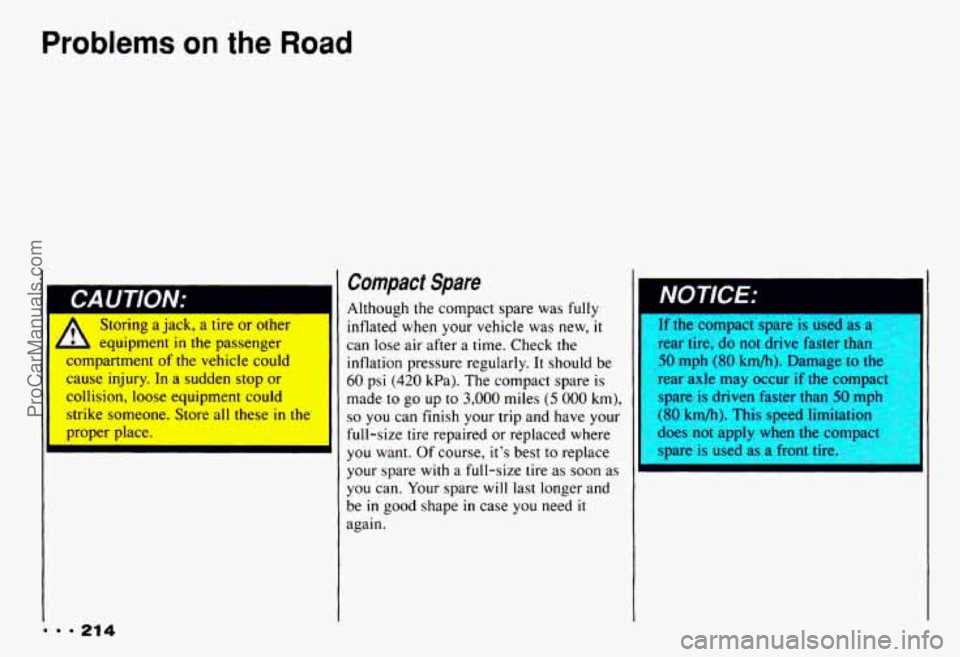
Problems on the Road
II , Storing aJacK, a tlre or otner I
4 equipment in the passenger
Ldmpartment of the vehicle could
cause injury. In a sudden
stop or
collision, loose equipment could
strike someone. Store all these
in the
proper place.
Compact Spare
Although the compact spare was fully
inflated when your vehicle was new, it
can lose air after a time. Check the
inflation pressure regularly.
It should be
60 psi (420 kPa). The compact spare is
made to go up to 3,000 miles (5 000 km),
so you can finish your trip and have your
full-size tire repaired or replaced where
you want. Of course,
it’s best to replace
your spare
with a full-size tire as soon as
you can. Your spare
will last longer and
be
in good shape in case you need it
again.
NOTICE:
lr tne compact spare 1s use0 as a
rear tire, do not drive faster than
50 mph (80 km/h). Damage to the
rear axle may occur
if the compac
snare
is driven faster than 50 mnh
( 0 km/h). This speed limitatia
does
not apply when the COI
ware is used as a front tire.
ProCarManuals.com
Page 259 of 358
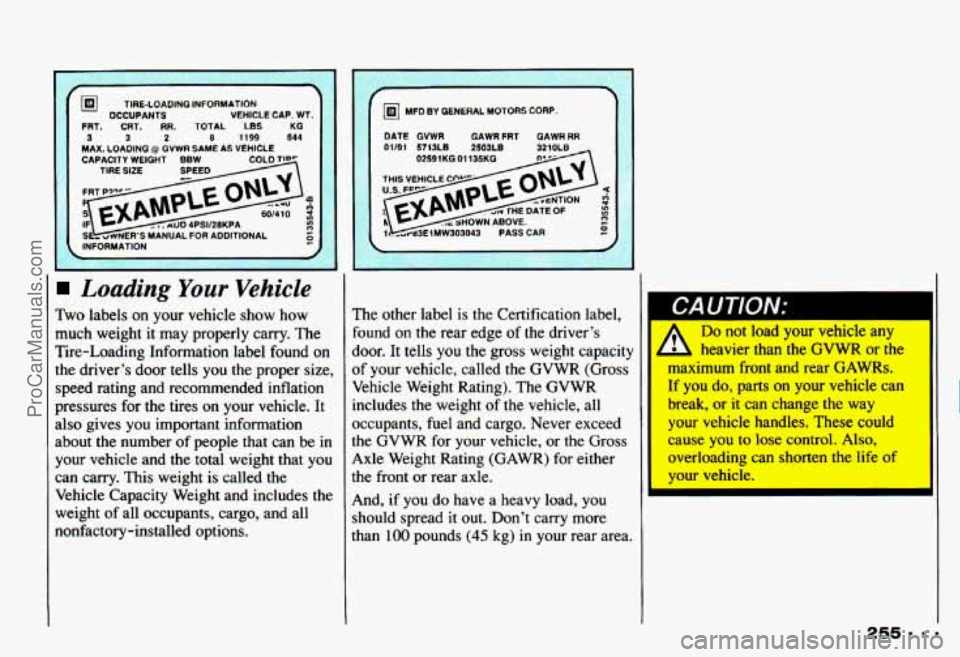
CAPACITY WEIGHT BBW TIRE SIZE
INFORMATION
Loading Your Vehicle
Two labels on your vehicle show how
much weight it may properly carry. The
Tire-Loading Information label found on
the driver’s door tells
you the proper size,
speed rating and recommended inflation
pressures for
the tires on your vehicle. It
also gives you important information
about the number of people that can be in
your vehicle and the total weight that
you
can carry. This weight is called the
Vehicle Capacity Weight and includes the
weight of all occupants, cargo, and all
nonfactory-installed options.
DATE GVWR GAWRFRT GAWR RR 01/91 5713LB ZS03LB <. .
v)
The other label is the Certification label,
found on
the rear edge of the driver’s
door. It tells you the gross weight capacity
of your vehicle, called the GVWR (Gross
Vehicle Weight Rating). The GVWR
includes the weight of the vehicle, all
occupants, fuel and cargo. Never exceed
the GVWR for your vehicle,
or the Gross
Axle Weight Rating (GAWR) for either
the front or rear axle.
And,
if you do have a heavy load, you
should spread it out. Don’t carry more
than
100 pounds (45 kg) in your rear area.
Do not load your vehicle any
- L heavier than the GVWR or the
maximum front and rear GAWRs.
If you do, parts on your vehicle can
break, or
it can change the way
your vehicle handles. These could
cause you to lose control.
Also,
overloading can shorten the life of , ,
II
ProCarManuals.com
Page 261 of 358
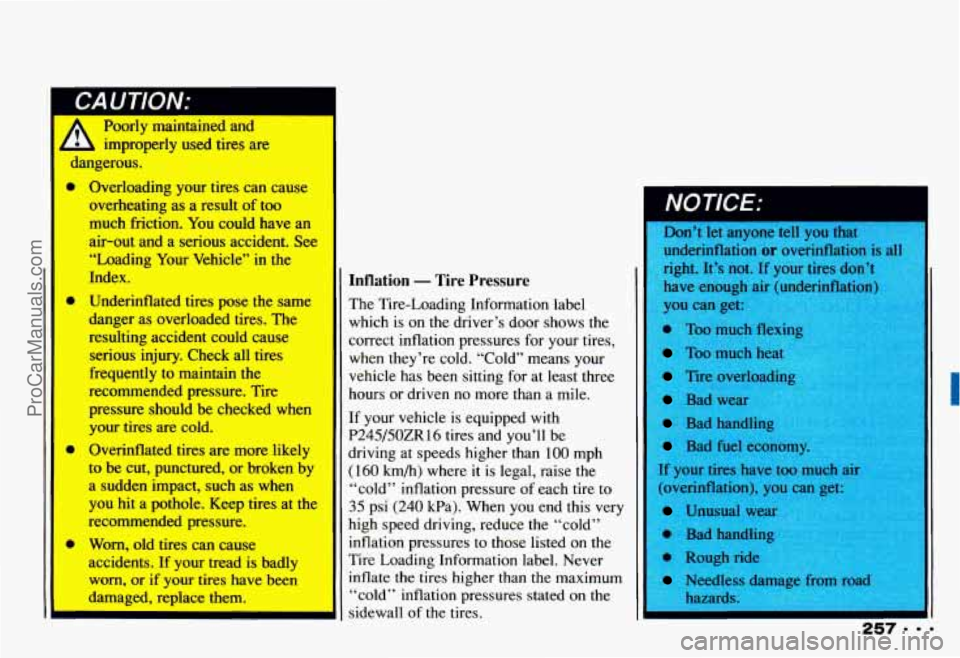
CAUTION:
Poorly maintained and
improperly used tires are
dangerous.
a
m
a
Overloading your tires can cause
overheating as
a result of too
much friction. You could have
an
air-out and a serious accident. See
“Loading Your Vehicle” in the
Index.
Underinflated tires pose the
same
danger as overloaded tires. The
resulting accident could cause
serious
injury. Check all tires
frequently to maintain the
recommended
pressure. Tire
pressure should
be checked when
your tires are cold.
Overinflated tires
are more likely
to be cut, punctured, or broken by
a sudden impact, such as when
you
hit a pothole. Keep tires at the
recommended pressure.
Worn, old tires can cause
accidents.
If your tread is badly
worn, or if your tires have been
damaged, replace them.
I
Inflation - Tire Pressure
The Tire-Loading Information label
which
is on the driver’s door shows the
correct inflation pressures for your tires,
when they’re cold. “Cold” means your
vehicle has been sitting for at least three
hours or driven no more than a mile.
If your vehicle is equipped
with
P245/50ZR16 tires and you’ll be
driving at speeds higher than
100 mph
(160 km/h) where it is legal, raise the
“cold” inflation pressure of each tire to
35 psi (240 kPa). When you end this very
high speed driving, reduce the “cold”
inflation pressures to those listed on the
Tire Loading Information label. Never
inflate the tires higher than the maximum
“cold” inflation pressures stated on the
sidewall of the tires. Don’t let anyone tell
you that
underinflation
or overinflation is all
right. It’s not.
If your tires don’t
haveenougha
n)
you can get
e Too muc
Too much heal
Tire overloading
Bad wear
Bad handli
Bad fuel econ
I If your tires have too much air
(overinflation), you
can get’
Unusual wear
’ 0 Bad handling
e Rough ri,,
Needless damage fi~111
hazards.
~
I
ProCarManuals.com
Page 262 of 358
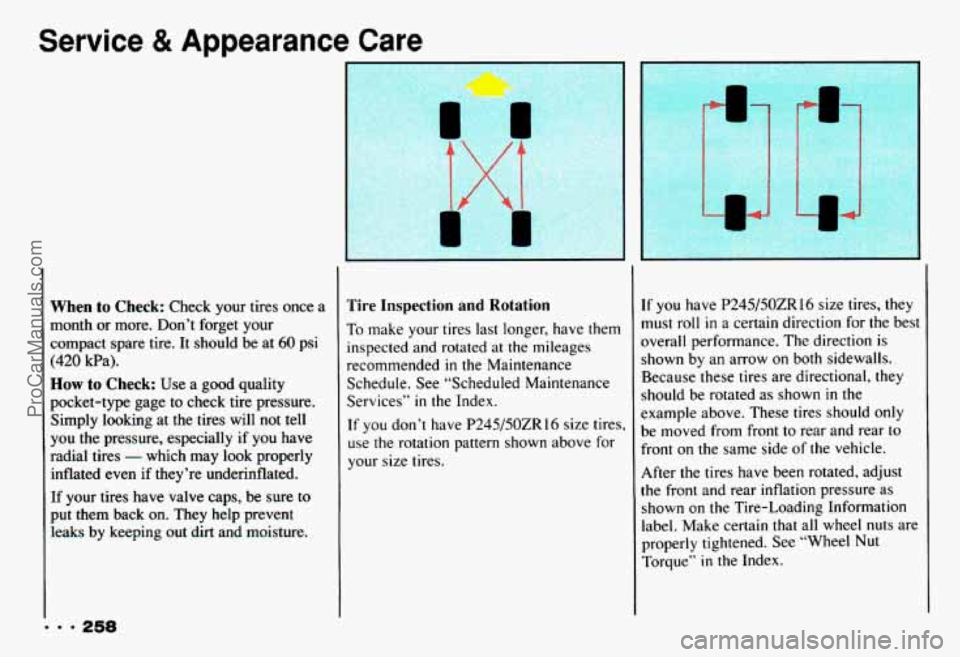
Service & Appearance Care
9 9 9 258
When to Check: Check your tires once a
month
or more. Don’t forget your
compact spare tire. It should be at
60 psi
(420 kPa).
How to Check: Use a good quality
pocket-type gage to check tire pressure.
Simply looking at the tires will not tell
you the pressure, especially if you have
radial tires
- which may look properly
inflated even if they’re underinflated.
If your tires have valve caps, be sure to
put them back on. They help prevent
leaks by keeping out
dirt and moisture.
L
’
Tire Inspection and Rotation
To make your tires last longer, have them
inspected and rotated at the mileages
recommended
in the Maintenance
Schedule. See “Scheduled Maintenance
Services”
in the Index.
If you don’t have
P245/50ZR 16 size tires,
use the rotation pattern shown above for
your size tires. If
you have P245/50ZR16 size tires, they
must roll
in a certain direction for the best
overall performance. The direction is
shown by an arrow on both sidewalls.
Because these tires are directional, they
should
be rotated as shown in the
example above. These tires should only
be moved from front to rear and rear to
front on the same side of the vehicle.
After the tires have been rotated, adjust
the front and rear inflation pressure as
shown on the Tire-Loading Information
label. Make certain that all wheel nuts are
properly tightened. See “Wheel
Nut
Torque” in the Index.
ProCarManuals.com
Page 303 of 358
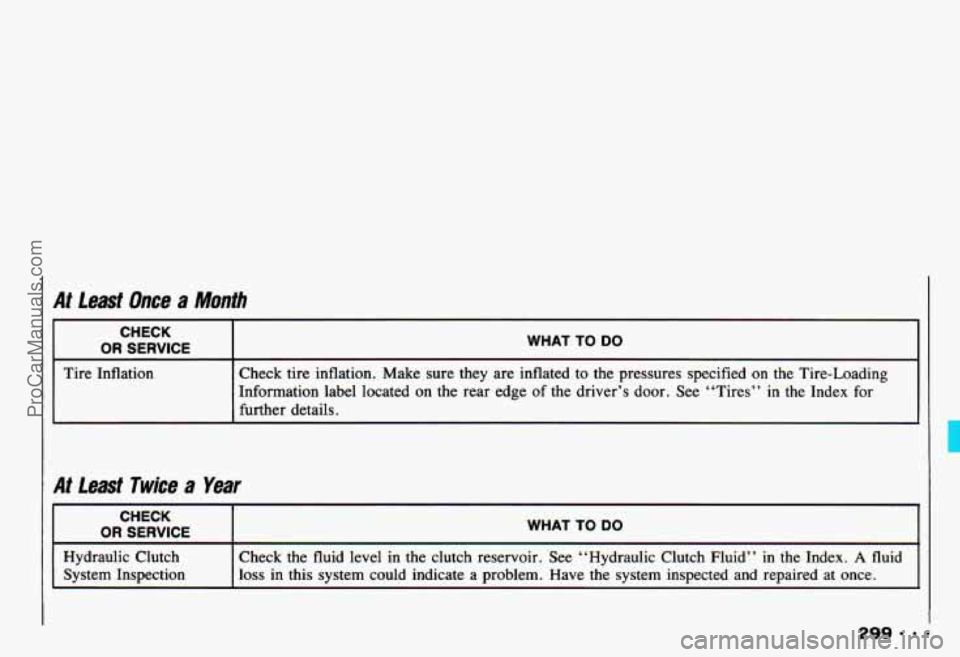
At least Once a Month
CHECK
OR SERVICE I WHAT TO DO
Tire Inflation Check tire inflation. Make sure they are inflated to the pressures specified on the Tire-Loading
Information label located on the rear edge
of the driver’s door. See “Tires” in the Index for
further details.
At least Twice a Year
CHECK
I OR SERVICE I WHAT TO DO
Hydraulic Clutch Check the fluid level in the clutch reservoir. See “Hydraulic Clutch Fluid” in the Index. A fluid
System Inspection loss in this system could indicate a problem. Have the system inspected and repaired at once.
ProCarManuals.com
Page 340 of 358

9 9 9 336
Inflation . Tire Pressure ......... 257
Instrument Panel ............... 96
Instrument Panel and Clusters ..... 98
Instrument Panel. Cleaning the Top
of ..................... 269
Interior Lights ................. 86
Jump Starting ................ 185
Keys ........................ 48
Lane Change Indicator.
Turn Signal
and .............. 77
Lap-Shoulder Belt (Safety
Belts)
...................... 21
Larger Children (Seats and
Safety Belts)
................. 43
Latches. Front Seatback .......... 14
Leaving the Freeway ........... 162
Leaving Your Vehicle with the
Engine Running
.............. 72
Lighter. Ashtray and ............. 94
Lights Air Bag System
.............. 26
Anti-lock Brake System
Brake System Warning
........ 100
Bulb Replacement ........... 279
Check Gages ............... 105
Courtesy .................... 86
Daytime Running ............. 85
Fog ........................ 86
Front Map ................... 87
Gages and Indicators. Warning . . 99
Interior ..................... 86
Warning ................. 101
Low Coolant ................ 105
Low Oil ................... 105
Main Control ................ 85
Operation of ................. 84
Safety Belt Reminder .......... 20
Service Engine Soon ......... 103
Traffic ..................... 134
Lights On Reminder ............. 85
Limited-Slip Rear Axle .......... 70
Loading Your Vehicle .......... 255
Locks
Door
....................... 50
Power Door ................. 51
Long Distance. Driving a ........ 163
Loss of Control ............... 151
Low Coolant Light ............. 105
Low Oil Light ................ 105
Malfunction Indicator Lamp ... 103
ProCarManuals.com
Page 346 of 358
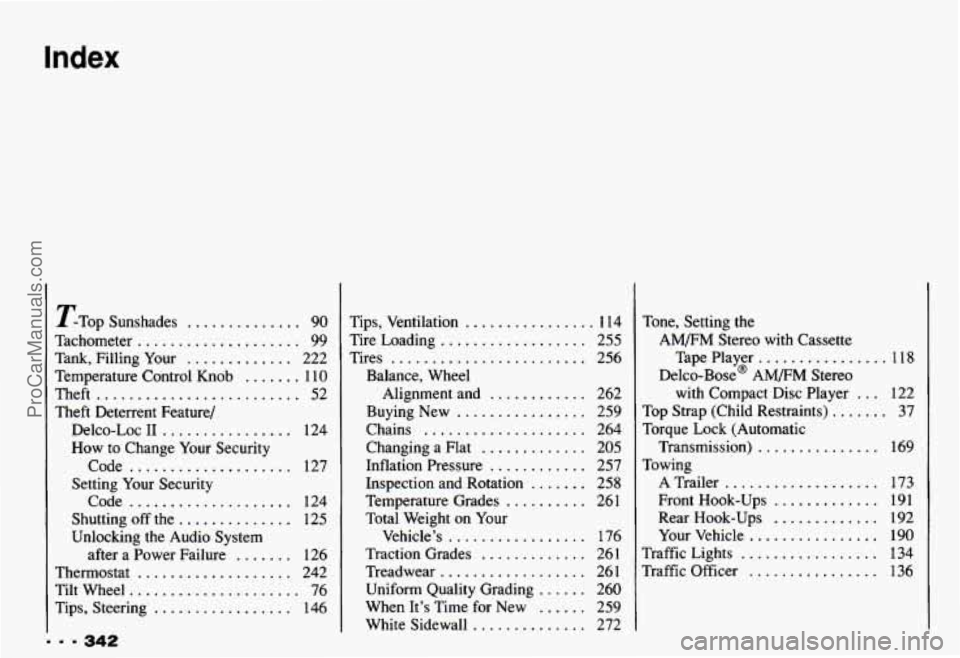
Index
... 342
TTop Sunshades .............. 90
Tachometer
.................... 99
Tank. Filling Your ............. 222
Temperature Control Knob
....... 110
Theft ......................... 52
Theft Deterrent Feature/
Delco-Loc
I1 ................ 124
How to Change Your Security
Code
.................... 127
Setting Your Security
Code
.................... 124
Shutting
off the .............. 125
Unlocking the Audio System after a Power Failure
....... 126
Thermostat
................... 242
Tilt Wheel
..................... 76
Tips. Steering
................. 146 Tips. Ventilation
................ 1 14
Tire Loading
.................. 255
Tires
........................ 256
Balance. Wheel
Alignment and
............ 262
Buying New
................ 259
Chains .................... 264
Inflation Pressure
............ 257
Changing a Flat
............. 205
Inspection and Rotation
....... 258
Temperature Grades
.......... 261
Total Weight on Your
Vehicle’s
................. 176
Traction Grades
............. 261
Treadwear
.................. 26 1
Uniform Quality Grading ...... 260
When It’s Time for New
...... 259
White Sidewall
.............. 272 Tone.
Setting the
AM/FM Stereo with Cassette
Delco-Base@ AMEM Stereo
Tape
Player
................ 118
with Compact Disc Player
... 122
Top Strap (Child Restraints)
....... 37
Torque Lock (Automatic
Towing Transmission)
............... 169
A Trailer
................... 173
Front Hook-Ups
............. 191
Rear Hook-Ups
............. 192
Your Vehicle
................ 190
Traffic Lights ................. 134
Traffic Officer
................ 136
ProCarManuals.com